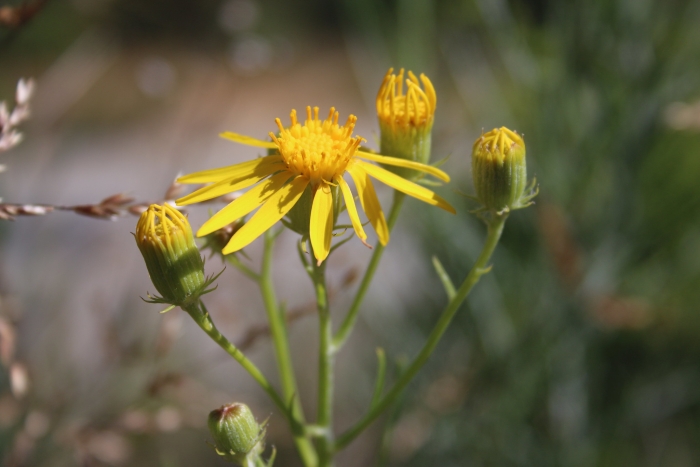Douglas’ Ragwort
(Senecio flaccidus var. douglasii)
Douglas’ Ragwort (Senecio flaccidus var. douglasii)
/
/

Joe Decruyenaere
CC BY-SA 2.0
Image By:
Joe Decruyenaere
Recorded By:
Copyright:
CC BY-SA 2.0
Copyright Notice:
Photo by: Joe Decruyenaere | License Type: CC BY-SA 2.0 | License URL: https://creativecommons.org/licenses/by-sa/2.0/ | Uploader: joedecruyenaere | Publisher: Flickr |
















Estimated Native Range
Summary
Senecio flaccidus var. douglasii, commonly known as Douglas’ Ragwort, is a semi-deciduous subshrub native to arid and semi-arid regions, including desert scrub, grasslands, and open woodlands in the Southwestern United States, California, and Northeastern Mexico. It typically grows to a height of 3-4 feet (0.9-1.2 meters) and a width of 2-3 feet (0.6-0.9 meters). Douglas’ Ragwort has a sprawling form with narrow, silver-gray leaves that add a fine texture to garden compositions. It produces bright yellow, daisy-like flowers from late spring to early fall, which are moderately showy and attract pollinators.
Douglas’ Ragwort is valued for its drought tolerance and ability to thrive in challenging environments, making it suitable for xeriscaping and naturalistic plantings. It is often used in rock gardens, as a ground cover, or in borders where its low water needs and long blooming season are advantageous. This plant prefers full sun but can tolerate some shade, and it requires well-drained soils. While it is generally low-maintenance, it can be susceptible to root rot if overwatered. It is also important to note that Senecio species can be toxic if ingested, so caution should be exercised in gardens accessible to pets and children.CC BY-SA 4.0
Douglas’ Ragwort is valued for its drought tolerance and ability to thrive in challenging environments, making it suitable for xeriscaping and naturalistic plantings. It is often used in rock gardens, as a ground cover, or in borders where its low water needs and long blooming season are advantageous. This plant prefers full sun but can tolerate some shade, and it requires well-drained soils. While it is generally low-maintenance, it can be susceptible to root rot if overwatered. It is also important to note that Senecio species can be toxic if ingested, so caution should be exercised in gardens accessible to pets and children.CC BY-SA 4.0
Plant Description
- Plant Type: Shrub
- Height: 3-4 feet
- Width: 2-3 feet
- Growth Rate: Moderate
- Flower Color: Yellow
- Flowering Season: Fall, Summer
- Leaf Retention: Evergreen
Growth Requirements
- Sun: Full Sun
- Water: Very Low, Low
- Drainage: Fast
Common Uses
Bee Garden, Butterfly Garden, Drought Tolerant, Low Maintenance, Rabbit Resistant, Showy Flowers
Natural Habitat
native to arid and semi-arid regions, including desert scrub, grasslands, and open woodlands in the Southwestern United States, California, and Northeastern Mexico
Other Names
Common Names: Butterweed, Bush Senecio, Douglas’ Shrubby Ragwort, Threadleaf Groundsel
Scientific Names: , Senecio flaccidus var. douglasii, Senecio douglasii, Senecio douglasii var. douglasii, Senecio douglasii var. tularensis, Senecio douglasii subsp. douglasii,
GBIF Accepted Name: Senecio flaccidus var. douglasii (DC.) B.L.Turner & T.M.Barkley